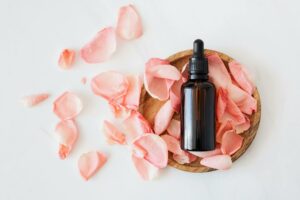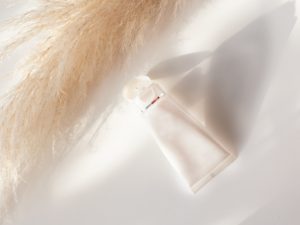How to Choose and Layer Skincare – Find the right routine for your skin type today
Not even gonna stall: the basic steps in skincare are cleansing, treating, moisturizing, and SPF.

But there’s more you can do to target certain skin concerns, and a step you should be doing at LEAST once a week (depending on skin type).
Keep reading to learn how to build a skincare routine that’s right for you! From oily skin and acne-prone, to dry and sensitive, and any combo in between, learn about different ingredients and how to target every concern you may have!
Step One: Cleanse
This step is important to everyone, whether you wear makeup or not.
Cleansing your skin is just like it sounds, cleaning it from makeup, dirt, environmental impurities, or other products like sunblock.
Some people cleanse twice a day, once in the morning, once at night. This can be reduced to once a day, at night, especially for people with drier or sensitive skin.
People who use makeup live by the double cleansing routine at night, where you use a balm or oil to break down makeup, and another cleanser to remove everything.
Cream-based cleansers work well for dry skin while foaming cleansers are better for oily skin. Oily skin or acne-prone skin may also benefit from a salicylic acid cleanser for oil and blemish control. Sensitive skin may benefit from using oat-based balms.
Cleansers should be free from ingredients that disrupt the skin’s natural barrier. Look for cleansers with ceramides for skin support.
Step Two: Treatment
Treatment is any product or serum designed to target skin concerns. Here is the breakdown of different treatment options.
Many of these come in the form of serums that can absorb quickly into the skin right after cleansing and before moisturizing.
Hydrating Ingredients
Hydrating serums are great for anyone looking to retain moisture. Many of these are humectant, meaning they draw in water from the air to hydrate the skin.
- Hyaluronic Acid – skin plumping and hydrating, a humectant that helps draw in moisture into the skin.
- Glycerin – a powerful humectant that hydrates, plumps, and radiates the skin.
- Collagen – in skincare, collagen does not penetrate deep enough to alter skin collagen but it does hydrate and plump skin.
Oil Control Ingredients
The good thing about these ingredients is that they can be used by people who don’t have oily skin.
- Niacinamide – regulates oil production, minimizes pores, and treats hyperpigmentation. Calms skin and soothes redness.
- Salicylic acid – serums with this ingredient offer acne treatment as well as oil control.
Antioxidant Ingredients
Antioxidant serums may help improve skin texture, fade dark marks, and prevent breakouts.
- Vitamin C – enhances skin protection against environmental damage. Do not combine with retinol as it can lead to irritation (alternate use of days, or use C in the AM and retinol in the PM)
- Vitamin E- offers protection against environmental free radicals. Improves signs of aging.
Anti-aging Ingredients
These ingredients can help reduce signs of again or improve collagen.
- Retinol – retinol increases collagen production and protects collagen already in the skin. It has anti-acne properties, reduces dark spots, and reduces wrinkles. Do not combine with Vitamin C as it can lead to irritation (alternate use of days, or use Vitamin C in the AM and retinol in the PM). Retinol is best in a nighttime skincare routine as it increases skin sensitivity.
- Vitamin C – this, while being an amazing antioxidant, can help restore and protect collagen in the skin. Use a morning skincare routine to protect the skin from damage.
Calming Ingredients
Calming serums are great for sensitive skin, reducing inflammation, redness, or irritation.
- Oat extract – good for dry, irritated, and sensitive skin, it can smooth and fortify skin.
- Sunflower extract – calms and soothes irritation.
Step Three: Moisturize
Everyone, dry, oily combo, acne-prone, or otherwise, should moisturize!
Regardless of skin type, protecting your skin and supporting it with a moisturizer that supports the skin barrier is important.
If you have dry skin, try looking for a cream moisturizer as these are thicker and more hydrating. If you want lightweight moisture, try a gel moisturizer, a good option especially if you have oily or acne-prone skin. Lotions tend to work for combo or normal skin, as they are not as thick as creams, but not as light as gels.
Moisturizers can have essential ingredients. For example:
Peptides – help hydrate and reduce the appearance of wrinkles. Increases skin elastin and eases inflammation
Ceramides – restore and repair the skin barrier
Antioxidants – like vitamins C, E and B can help add glow and protection to the skin.
Some moisturizers come with essential treatment ingredients like niacinamide, hyaluronic acid, or retinol, so be sure to read the ingredient list to know exactly what you are putting on your face.
Step Four: SPF (in the morning)
Sun protection is essential in your daily skincare routine. This can be applied in the morning before stepping out and reapplying as needed.
There are many different types of sunblocks to choose from, all with different properties.
Mineral Sunscreens use zinc oxide or titanium oxide. They bounce light off the surface of the skin.
Chemical Sunscreens absorb UV radiation so that it doesn’t penetrate the skin. This includes avobenzone, octisalate, homosalate, and octinoxate.
Some sunscreens even combine both.
Apply sunscreen after moisturizer in the morning and wait 20 minutes before going out into the sun.
Step Five: Exfoliate (at least once a week)
Exfoliating is the process of removing dead skin cells from the top layer of your skin.
Shedding and regeneration are normal but when dead skin cells skin stick, exfoliating can help remove them.
This can be great in helping unclog pores, brighten your complexion, reduce dark spots, and make room for new cells!
All skin is unique however and there is no set universal guide to exfoliating. Start with gentle exfoliating products, such as lactic acid, and work your way up to more times a week or a stronger exfoliate.
Try to avoid mechanical exfoliates, such as scrubs, as these can lead to physical damage on the skin and excess dryness.
Many experts recommend 2 to 3 times a week, though this depends on the strength of the exfoliate, and skin concerns you may have.
Lactic acid is softer and can be used more frequently.
Glycolic acid is stronger and may be used in your t-zone more often than the entire face.
Oily skin or mature skin may exfoliate more often than dry skin and sensitive skin.
The order this goes into skincare depends on the product. Some exfoliates come in cleansers, some in the form of serums.
For example, lactic acids can come in serums while salicylic acid can be found as a cleanser or spot treatment. Some lotions even contain salicylic acid, for soft oily control and blemish reduction.
The Takeaway
Skincare routines can help target certain areas of concern, from dryness to acne.
Learning what a product does can go a long way in helping reduce problem areas on the skin.
Use cream cleansers for dry skin, foaming ones for oily skin, and ones with salicylic acid for acne-prone skin.
Everyone needs to moisturize (yes, even my oily skin pals), but choose the right one for you. Use cream moisturizers for dry skin and gel ones for oil skin.
Ingredients such as ceramides are good for everyone as they help restore your skin’s natural barrier.
Remember! Exfoliating too much can cause skin sensitivity, inflammation, and even acne! So use gently exfoliates, and start off slowly.
Take step to improve your overall wellbeing, one day at a time!





